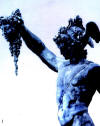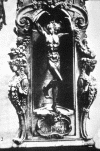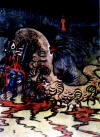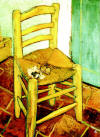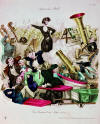The Effects of Diseases, Drugs, and Chemicals on the Creativity and Productivity of Famous Sculptors, Classic Painters, Classic Music Composers, and Authors
Ed. Note: Paul L. Wolf, MD from the Department of Pathology and Laboratory Medicine at the University of California, San Diego, in a recently published article (Archives of Pathology and Laboratory Medicine: Vol. 129, No. 11, pp. 1457-1464. November 2005) takes us on a journey of retrograde analysis of medical conditions and self-induced medicinal ingestion that afflicted some of the most talented artists ever (Benvenuto Cellini, Michelangelo Buonarroti, Ivar Arosenius, Edvard Munch, van Gogh, and Berlioz). His conclusion: these talents could have been diagnosed and treated by today's methods, but the intervention may have dimmed or extinguished the "spark".
Below is the analysis that Dr. Wolf uses to illustrate his historical perspective.
From the Department of Pathology and Laboratory Medicine, University of California, San Diego, and the Autopsy and Hematology, Clinical Chemistry Laboratories, VA Medical Center, San Diego, Calif
Context.- Many myths, theories, and speculations exist as to the exact etiology of the diseases, drugs, and chemicals that affected the creativity and productivity of famous sculptors, classic painters, classic music composers, and authors.
Objective.- To emphasize the importance of a modern clinical chemistry laboratory and hematology coagulation laboratory in interpreting the basis for the creativity and productivity of various artists.
Design.- This investigation analyzed the lives of famous artists, including classical sculptor Benvenuto Cellini; classical sculptor and painter Michelangelo Buonarroti; classic painters Ivar Arosenius, Edvard Munch, and Vincent Van Gogh; classic music composer Louis Hector Berlioz; and English essayist Thomas De Quincey. The analysis includes their illnesses, their famous artistic works, and the modern clinical chemistry, toxicology, and hematology coagulation tests that would have been important in the diagnosis and treatment of their diseases.
Conclusions.- The associations between illness and art may be close and many because of both the actual physical limitations of the artists and their mental adaptation to disease. Although they were ill, many continued to be productive. If modern clinical chemistry, toxicology, and hematology coagulation laboratories had existed during the lifetimes of these various well-known individuals, clinical laboratories might have unraveled the mysteries of their afflictions. The illnesses these people endured probably could have been ascertained and perhaps treated. Diseases, drugs, and chemicals may have influenced their creativity and productivity.
The phrase "the inhumanity of medicine" has been used by Sir David Weatherall, Oxford's Regius Professor of Medicine, for a kind of sickness in modern technological medicine.1 In 1919, one of his predecessors, Sir William Osler, had the remedy for that complaint. Osler suggested that the "arts" secrete materials that do for society what the thyroid does for human beings. The arts, including literature, music, painting, and sculpture, are the hormones that enhance an increased human approach to the medical profession.2,3
Illness has affected the artistic achievement of musical composers, classical painters, creative authors, and sculptors. Illness affected their physical and mental status as well. Their inspiration may have been shaped by their human condition. The associations between illness and art may be close and many because of both the actual physical limitations of the artists and their mental adaptation to disease. Although they were ill, many continued to be productive. The afflictions these people endured probably could have been ascertained and perhaps treated with modern medical techniques.
This article analyzes the effects of drugs, chemicals, and diseases on the creativity and productivity of the famous sculptors Benvenuto Cellini and Michelangelo Buonarroti; classic painters Ivar Arosenius, Edvard Munch, Vincent van Gogh, and Michelangelo; classic music composer Louis Hector Berlioz; and author Thomas De Quincey.
BENVENUTO CELLINI
A Homicidal Attempt on Cellini Utilizing Sublimate (Mercury)
|
Click to enlarge Figure 1.Benvenuto Cellini's gigantic masterpiece sculpture Perseus With the Head of Medusa. This statue stands in the Loggia Dei Lanzi in Florence, Italy. Reprinted with permission from Blackwell Publishing, Ltd |
Benvenuto Cellini (1500-1571) was one of the world's greatest sculptors and a connoisseur of sensuous living. He produced a gigantic masterpiece Perseus With the Head of Medusa. The casting of it was an artistic feat. Cellini was a Renaissance man in every sense. He was a goldsmith, sculptor, musician, and a swaggering figure that saw himself as Michelangelo's artistic equal.
Cellini contracted syphilis at the age of 29 years.4 When he was in the secondary stage of syphilis with a vesicular rash, he was advised to have mercury therapy, but refused because he had heard of the undesirable effects of mercury.5 He received lotion therapy, and leeches were also applied. However, the "syphilis pox" skin rash relapsed. Cellini subsequently became ill with malaria, which was common in Rome at the time. The malaria caused him to become extremely febrile and led to improvement of his symptoms following attenuation of the spirochetes by the high fever. The Romans and the Greeks believed that malaria was due to "bad air"; thus, it was called mal (bad) aria (air). They were not aware that it was caused by a parasite. The fever of malaria obviously had a transient, minimal effect on the clinical course of Cellini's syphilis. In 1539, Roy Diaz De Isla observed the minimal therapeutic value of malaria on syphilis.6 Four hundred years later, in 1927, the Nobel Foundation awarded a Nobel Prize to Julius Wagner Jauregg for malaria therapy of syphilis, which was ineffective, as demonstrated in Cellini's case in 1529.
Subsequently, Cellini developed tertiary syphilis, which resulted in grandiose projects due to his megalomania and which led him to initiate his sculpture of Perseus. He fell easy prey to individuals attempting to capitalize on his grandiosity, his wealth, and his influential reputation. He made a disadvantageous property purchase from clever business individuals who suspected that Cellini was in a terminal phase of syphilis. These salespeople produced a plot to murder Cellini to hasten the realization of their investments. The assassins prepared a meal in which they added mercury to a sauce. After eating the meal, Cellini quickly developed a severe hemorrhagic diarrhea. He suspected that he had been poisoned with sublimate (mercury). Fortunately for Cellini, the dose of mercury in the sauce was not large enough to cause his death, but it was sufficient to cure his syphilis. He decided not to prosecute his would-be assassins, but to honor them as his therapists. Instead of dying of syphilis, Cellini lived many more years. A modern clinical chemistry laboratory might have confirmed the presence and level of mercury by examination of Cellini's urine when he was poisoned. The modern analytic procedure for detection and quantitation of mercury includes atomic absorption spectrometry. Numerous signs and symptoms are present with mercury poisoning, including a metallic taste, stomatitis, gastroenteritis, urticaria, vesication, proteinuria, renal failure, acrodynia, peripheral neuropathy with paresthesia, ataxia, and visual and hearing loss. The half-life of mercury poisoning is 40 days. The modern treatment of mercury poisoning is the utilization of meso-2,3 dimercaptosuccinic acid.
Cellini's magnificent bronze sculpture Perseus With the Head of Medusa (Figure 1 ), stands on a pedestal that Cellini crafted. Cellini placed the mythical Mercury opposite the multibreasted Diana of Ephesus, or Venus, the goddess of love and beauty (possibly the venereal disease goddess as well) on the base of the statue of Perseus (Figure 2 ). A possible interpretation of this juxtaposition is that Cellini has demonstrated the cause and cure of his disease.
MICHELANGELO
A Brilliant Sculptor and Painter Who Projected His Own Illnesses Into His Sculpture and Paintings
Michelangelo Buonarroti (1475-1564) was born in March 1475 in Caprese, Tuscany. He lived and worked for nearly a century and worked continuously until 6 days before his death. He was considered to be a Renaissance man. He depicted a number of his mental and physical conditions in his paintings and sculpture, as did subsequent painters hundreds of years later.
|
Click to enlarge Figure 3. A, Michelangelo's portrait is present in Raphael's School of Athens painting. In the School of Athens, Plato (a portrait of Leonardo da Vinci) discourses with Aristotle. Located at the Stanza della Segnatura, Vatican Palace, Vatican State. Photo credit: Erich Lessing, Art Resource, New York, NY. |
Michelangelo developed various illnesses during his lifetime. Michelangelo's right knee was swollen and deformed by gout, which is depicted in a fresco by Raphael (Figure 3, A and B). This painting is present in the Vatican and was commissioned by Pope Julius II when Michelangelo was known to be on site at the Vatican completing his paintings on the ceiling of the Sistine Chapel. Michelangelo is shown with a gouty, deformed right knee.7 Michelangelo suffered from gout caused by elevated serum uric acid, and his stone formation may have been urate urolithiasis.
Michelangelo stated that he had kidney and urinary bladder calculi throughout his life. In 1549, he had an episode of anuria, which was followed by the passing of gravel and stone fragments. In Michelangelo's case, gout might have explained the gravel in his urine. Plumbism should be considered as a possible cause for gout. Obsessed with his work, Michelangelo would go for days on a diet of bread and wine. At that time, wine was processed in lead containers. He might also have been exposed to lead-based paints. The fruit acids of wine, chiefly tartaric contained in crocks, are excellent solvents of lead in crocks coated with lead glaze. The wine thus contained high levels of lead. Lead injures the kidneys, inhibiting the excretion of uric acid and resulting in increased serum uric acid and gout. If a modern clinical chemistry laboratory had existed during Michelangelo's lifetime, his serum uric acid might have been found to be elevated. His urine might have contained excessive uric acid with uric acid calculi, as well as excessive lead levels. A modern clinical chemistry laboratory detects and quantitates serum uric acid with the uricase procedure. Uric acid urinary calculi are associated with needlelike, nonbirefringent crystals in the urine. Thus, Michelangelo may have suffered from saturnine gout.
Michelangelo also suffered from a number of illnesses besides gout. It was also known that he suffered from depression. He exhibited the signs and symptoms of a bipolar manic-depressive illness. He painted more than 400 figures on the ceiling of the Sistine Chapel from 1508 to 1512. His paintings mirror his depression. Features of melancholy appear in the painting of Jeremiah in the Sistine Chapel. Modern medicine has confirmed that manic-depressive illness and creativity tend to run in certain families. Studies of twins provide strong evidence for the heritability of manic-depressive illness. If an identical twin has manic-depressive illness, the other twin has a 70% to 100% chance of also having the disease; if the other twin is fraternal, the chances are considerably lower (approximately 20%). A review of identical twins reared apart from birth, in which at least one of the twins had been diagnosed as manic-depressive, found that in two-thirds or more of the cases the sets were concordant for the illness. If lithium carbonate had been available in the 16th century, it might have helped Michelangelo's depression if he suffered from a bipolar illness, and a clinical chemistry laboratory could have monitored serum lithium levels.
|
Figure 4. Michelangelo's painting Creation of Adam in the Sistine Chapel at the Vatican. A possible interpretation of this scene is that God is giving Adam either the "spark of life" or an intellect. Reprinted with permission from JAMA (1990;264:1840). Copyright 1990, American Medical Association. All rights reserved |
Michelangelo dissected numerous human bodies, beginning at the age of 18 years. The dissections occurred in the monastery of Santo Spirato in Florence, where the corpses originated from various hospitals. The anatomic accuracy of his figures is due to his dissection and his observations. In the painting The Creation of Adam (Figure 4 ) in the Sistine Chapel, an irregular circular structure appears surrounding God and the angels. One interpretation of the irregular circular structure is compatible with the shape of the human brain.8 However, others disagree and believe the circular structure surrounding God and the angels represents the human heart. At the left of the circle there is a cleavage, possibly separating the right and left ventricles. At the top right is a tubular structure, which may represent the aorta exiting from the left ventricle. Thus, the speculation persists that if it represents a brain, it suggests that God is giving Adam an intellect or a soul. If it is a representation of a heart, God is initiating in Adam the beginning of a cardiovascular system and life, and is thereby giving Adam the "spark of life."
IVAR AROSENIUS AND EDVARD MUNCH
|
Figure 5.Arosenius' famous painting Saint George Slaying the Dragon. This painting demonstrates that the dragon is bleeding profusely following his slaying by Saint George. Arosenius is depicting his profound bleeding tendency due to his hemophilia. (I. Arosenius, St. George and the Dragon,by Ivar Arosenius. From Sandblom P. Creativity and Disease. Revised 9th ed. 1995: Figure 72. Reprinted with permission from Marion Boyars Publishers, London, Great Britain) |
Various other artists have depicted their illnesses in their works of art. Some examples include classic painters Ivar Arosenius (1878-1909) and Edvard Munch (1863-1944). Ivar Arosenius was a Swedish painter especially known for his for his paintings of fairy tales. He died of excessive hemorrhage caused by hemophilia at approximately the age of 30 years. His painting Saint George and the Dragon demonstrates a dragon that is bleeding profusely following his slaying by Saint George (Figure 5 ). The dragon bled convincingly and very profusely. A modern coagulation laboratory would have detected the genetic abnormality for hemophilia, and appropriate therapy with recombinant hemophilia factors could have been instituted. The Swedish Hemophilia Society has established an Arosenius Fund aiding hemophilia patients.
Edvard Munch may have depicted his own psychotic state of mind when he painted The Scream (The Shriek). Munch, a Norwegian painter, used intense colors in his paintings. Another possible interpretation of the event that inspired The Scream (The Shriek) is in an entry in one of Munch's numerous journals. Munch makes clear in the journal entry that The Scream (The Shriek) grew from an experience he had while walking near Oslo at sunset.
The Scream (The Shriek) may have been the direct consequence of a cataclysm half a world away from Norway, that is, the volcanic explosion on the Indonesian island of Krakatoa. The huge explosion, which occurred in August 1883, and the tsunamis it generated killed approximately 36000 people. It lofted huge amounts of dust and gases high into the atmosphere, where they remained airborne and in the next several months spread over vast parts of the globe. A report on Krakatoa's effects issued by The Royal Society of London provided "Descriptions of the Unusual Twilight Glows in Various Parts of the World, in 1883-4," including appearing in the Norwegian twilight skies. Munch, too, must have been startled, even frightened, the first time he witnessed the fiery spectacle in late 1883. Munch's sister, Laura, suffered from schizophrenia. Molecular genetic psychiatrists have searched for the genetic roots of schizophrenia.
The late Philip Holzman, PhD, professor of psychology at Harvard University and an authority on schizophrenia, was convinced that schizophrenia was broader than the psychotic phenomena and that it included many behaviors that occur in unaffected relatives of the schizophrenic patients. Modern pathology departments have established molecular genetics divisions that focus on the genetic causes of disease. In the future, these laboratories might discover a genetic root for schizophrenia.
VINCENT VAN GOGH (1853-1890)
The Chemistry of His Yellow Vision
The color yellow fascinated the Dutch postimpressionist painter, Vincent van Gogh, in the last years of his life. His house was entirely yellow. He wrote How Beautiful Yellow Is, and all of his paintings in these years were dominated by yellow. Van Gogh's preference for the color yellow may have been that he simply liked the color (Figure 6 ). However, 2 speculations exist that his yellow vision was caused by overmedication with digitalis or excessive ingestion of the liqueur absinthe. The drink contains the chemical thujone. Distilled from plants such as wormwood, thujone poisons the nervous system. The chemistry of the effect of digitalis and thujone resulting in yellow vision has been identified. It also should be noted, prior to the discussion of van Gogh's yellow vision, that many clinicians have reviewed the medical and psychiatric problems of the painter posthumously, diagnosing him with a range of disorders, including epilepsy, schizophrenia, digitalis and absinthe poisoning, manic-depressive psychosis, acute intermittent porphyria. Psychiatrist Kay R. Jamison, PhD, believes that van Gogh's symptoms, the natural course of his illness, and his family psychiatric history strongly indicate manic-depressive illness. It is also possible that he suffered from both epilepsy and manic-depressive illness.9 If lithium carbonate had been available in the 19th century, it might have helped Van Gogh.
The Effect of Digoxin on the Retina and the Nervous System, Resulting in Yellow Vision
|
Figure 6.Van Gogh's painting of a Chair and Pipe. This painting emphasizes Van Gogh's preference for the color yellow. Vincent van Gogh (1853-1890). Vincent's Chair, 1888-1889. Oil on canvas. Located at the National Gallery, London, Great Britain. Photo credit: Erich Lessing, Art Resource, New York, NY |
In 1785, William Withering observed that objects appeared yellow or green when foxglove was given therapeutically in large and repeated doses.10 Since 1925, various physicians, including Jackson,11 Sprague,12 and White,13 quoting Cushny, professor of pharmacology at the University of Edinburgh, have noted that patients overmedicated with digitalis develop yellow vision. According to Cushny, "All colors may be shaded with yellow or rings of light may be present."
It has been established that van Gogh suffered from epilepsy, for which he was treated with digitalis, as was often the case in the late 19th century.14 Barton and Castle15 stated that Parkinson recommended a trial use of digitalis in epileptics. Digitalis may have been used to relieve his epilepsy. Physicians are more likely to consider a diagnosis of digoxin toxicity if a history of xanthopsia (yellow vision) is elicited, this being the symptom best known to physicians.16
William Withering described many of the toxic effects of the cardiac glycosides in his classic treatise on foxglove in 1785: "The foxglove when given in very large and quickly repeated doses, occasions sickness, vomiting, purging, giddiness, confused vision, objects appearing green or yellow; - syncope, death." Since 1925, numerous studies have described the visual symptoms and attempted to identify the site of visual toxicity in digitalis intoxication.
The site of toxicity responsible for the visual symptoms has been debated for decades. Langdon and Mulberger17 and Carroll18 thought that the visual symptoms originated in the visual cortex. Weiss19 believed that xanthopsia was due to brainstem dysfunction. Demonstration of cellular alterations in the cerebral cortex and spinal cord of cats after administration of toxic doses of digitalis support the central dysfunction theory.
For many years, most investigators thought that the most likely site of damage in digitalis intoxication was the optic nerve. More recent investigations, however, have identified significant retinal dysfunction in digitalis toxicity and have shed some doubt on the older hypotheses.20 Support for a retinal site of toxicity has been provided by studies that have shown much higher accumulations of digoxin in the retina than in other tissues, including the optic nerve and brain.21 Digoxin toxicity might involve inhibition of sodium-potassium-activated adenosine triphosphatase, which has been identified in high concentration in the outer segments of the rods; inhibition of the enzyme could impair photoreceptor repolarization.22 Lissner and colleagues,23 however, found the greatest uptake of digoxin in the inner retinal layers, particularly in the ganglion cell layer, with little uptake in photoreceptors.
Another possible explanation for van Gogh's xanthopsia was his excessive ingestion of absinthe.24 Van Gogh's taste for absinthe (a liqueur) may have also influenced his style of painting. The drink's effect comes from the chemical thujone.25 Distilled from plants such as wormwood, thujone poisons the nervous system. Van Gogh had a pica (or hunger) for unnatural "foods," craving the entire class of fragrant but dangerous chemicals called terpenes, including thujone. As van Gogh recovered from cutting off his ear, he wrote to his brother: "I fight this insomnia with a very, very strong dose of camphor in my pillow and mattress, and if ever you can't sleep, I recommend this to you." Camphor is a terpene known to cause convulsions in animals when inhaled. Van Gogh had at least 4 such fits in his last 18 months of life.
Van Gogh's friend and fellow artist Paul Signac described an evening in 1889 when he had to restrain the painter from drinking turpentine. The solvent contains a terpene distilled from the sap of pines and firs. Van Gogh tried more than once to eat his paints, which contained terpenes as well. Signac also wrote that van Gogh, returning after spending the whole day in the torrid heat, would take his seat on the terrace of a cafe, with the absinthe and brandies following each other in quick succession. Toulouse-Lautrec drank absinthe from a hollowed walking stick. Degas immortalized absinthe in his bleary-eyed painting, Absinthe Drinker. Van Gogh nursed a disturbed mind on the aquamarine liqueur, which may have encouraged him to amputate his ear.
Absinthe is about 75% alcohol and has about twice the alcoholic volume of vodka. It is made from the wormwood plant, which is reputed to have a hallucinogenic effect, and is flavored with a blend of anise, angelica root, and other aromatics.
The chemical mechanism of α-thujone (the active component of absinthe) in neurotoxicity has been elucidated with identification of its major metabolites and their role in the poisoning process.26 α-thujone has a sort of double-negative effect on the brain. It blocks a receptor known as y-aminobutyric acid-A (GABA-A), which has also been linked to a form of epilepsy. Under normal conditions, GABA-A inhibits the firing of brain cells by regulating the flux of chloride ions. By essentially blocking the blocker, thujone allows the brain cells to fire at will. α-thujone acts at the noncompetitive blocker site of the GABA-A receptor and is rapidly detoxified, thereby providing a reasonable explanation for some of the actions of absinthe other than those caused by ethanol and allowing more meaningful evaluation of risks involved in the continued use of absinthe and herbal medicines containing α-thujone. Thus, the secret of absinthe, which is considered a fuel for creative fire, has been unlocked.
There is an increasing concern about the use of thujone substances with the rise in popularity of herbal medicines. Wormwood oil, which contains thujone, is present in some herbal preparations used to treat stomach disorders and other ailments. (In fact, wormwood, a relative of daisies, got its name from its use in ancient times as a remedy for intestinal worms.) Individuals ingesting these preparations have complained of developing yellow vision.27 Scientific studies of thujone are investigating the active ingredients in many herbal preparations. Absinthe is still manufactured in Spain and the Czech Republic. In modern absinthe, alcohol, which makes up three-quarters of the liqueur, may be the most toxic component. It is still illegal to buy absinthe in the United States, although it can be obtained through the Internet or when traveling overseas.
Recently, an article entitled "Poison on Line: Acute Renal Failure Caused by Oil of Wormwood Purchased Through the Internet" was published in the New England Journal of Medicine.28 In this article, a 31-year-old man was found at home in an agitated, incoherent, and disoriented state by his father. Paramedics noted tonic-clonic seizures with decorticate posturing. His mental status improved after treatment with haloperidol, and he reported finding a description of the liqueur absinthe at a site on the World Wide Web entitled "What is Absinthe?" The patient obtained one of the ingredients described on the Internet, essential oil of wormwood. The oil was purchased electronically from a commercial provider of essential oils used in aromatherapy, a form of alternative medicine. Several hours before becoming ill, he drank approximately 10 mL of the essential oil, assuming it was absinthe liqueur. This patient's seizure, probably caused by essential oil of wormwood, apparently led to rhabdomyolysis and subsequent acute renal failure.
This case demonstrates the ease of obtaining substances with toxic and pharmacologic potential electronically and across state lines. Chinese medicinal herbs, some of which can cause acute renal failure, are easily procured by means of the Internet. Although absinthe liqueur is illegal in the United States, its ingredients are readily available. Absinthe is also currently a popular drink in the bars of Prague, in the Czech Republic. The essential ingredient in this ancient potion was purchased in this case by means of up-to-the-minute computer technology.
A modern clinical chemistry and genetics laboratory could possibly have determined the following in van Gogh's case: (1) serum digitalis concentration, (2) serum thujone concentration, (3) urine porphobilinogen, and (4) serum lithium levels. These tests could possibly have confirmed that van Gogh suffered from chronic digitalis intoxication or intoxication from thujone related to excessive drinking of the liqueur absinthe. Modern tests could analyze his urine for the presence of porphobilinogen, which is the diagnostic test for acute intermittent porphyria, another speculated van Gogh illness. If Van Gogh had used lithium carbonate for bipolar illness, serum lithium levels might also have been important to monitor.
LOUIS HECTOR BERLIOZ AND THOMAS DE QUINCEY
Effects of Opium on Their Creativity and Productivity
Hector Berlioz (1803-1869) was born in France. His father was a physician who taught his son to appreciate classic literature. Berlioz's family attempted to interest him in studying medicine, but after his first year of medical school in Paris, he gave up medicine and became a music student instead. Berlioz entered the Paris Conservatoire of Music in 1826. As a boy, Berlioz adored both music and literature, and he went on to compose the Symphonie Fantastique, in which the hero (a thinly disguised representation of Berlioz himself) supposedly survives a large dose of narcotic. Another interpretation of the Symphonie Fantastique is that it describes the dreams of a jilted lover (Berlioz), possibly attempting suicide by an overdose of opium. This work is a milestone marking the beginning of the Romantic era of music.29 His creativity was fired in particular by a love for great literature and an unquenchable passion for the feminine ideal, and in the best of his works these elements conspired to produce music of exquisite beauty.
|
Figure 7.Hector Berlioz conducting one of his symphonies. Located at the Historisches Museum der Stadt Wien, Vienna, Austria. Photo credit: Erich Lessing, Art Resource, New York, NY |
Berlioz took opium to relieve agonizing toothaches, but there is no indication that he ever took opium to become intoxicated, as the author De Quincey did. On September 11, 1827, Berlioz attended a performance of Hamlet at the Paris Odéon, in which the actress Harriet Smithson (Berlioz later called her Ophelia and Henrietta) played the role of Ophelia. Overwhelmed by her beauty and charismatic stage presence, he fell desperately in love. The grim program of Symphonie Fantastique was born out of Berlioz's despair because of the unrequited love he had for the English Shakespearean actress Harriet Smithson.
Berlioz found a way to channel the emotional upheaval of "l'Affaire Smithson" into something he could control, that is, a "fantastic symphony" that took as its subject the experiences of a young musician in love. A detailed program Berlioz wrote prior to a performance of the Symphonie Fantastique, and which he later revised, leaves no doubt he conceived of this symphony as a romantically heightened self-portrait. Berlioz did eventually woo and win Miss Smithson, and they were married in 1833 at the British Embassy in Paris.
The program Berlioz wrote for Symphonie Fantastique reads, in part:
A young musician of morbid sensibility and ardent imagination in a paroxysm of love-sick despair has poisoned himself with opium. The drug too weak to kill plunges him into a heavy sleep accompanied by strange visions. His sensations, feelings, and memories are translated in his sick brain into musical images and ideas.
The underlying "theme" is obsessive and unfulfilled love. The symphony reflects Berlioz's hysteric nature with fits of frenzy, as revealed in his dramatic behavior (Figure 7 ).29
It was obvious that Berlioz was addicted to opium, which is a yellow to dark brown, addicting narcotic drug prepared from the juice of the unripe seed capsules of the opium poppy. It contains alkaloids such as morphine, codeine, and papaverine, and is used as an intoxicant. Medically, it is used to relieve pain and produce sleep. It is a tranquilizer and has a stupefying effect. Apart from alcohol, opium was the drug most commonly relied on in the 19th century, especially by poets for stimulating creative ability and for relief from stress.
Thomas De Quincey (1785-1859) was an English essayist. He wrote a rare kind of imaginative prose that was highly ornate, full of subtle rhythms, and sensitive to the sound and arrangement of words. His prose was as much musical as literary in its style and structure, and anticipated such modern narrative techniques as stream-of-consciousness.
De Quincey authored his most famous essay, Confessions of an English Opium-Eater, in 1821. He gave us an eloquent essay both of the delights and the agonies of opium abuse. He believed that the habit of eating opium was of common practice in his day and was not considered a vice. Originally, De Quincey believed that the use of opium was not to seek pleasure, but its use was intended for his extreme facial pain, which was caused by trigeminal neuralgia.30 The essay's biographical parts are important mainly as background for dreams De Quincey describes later. In these dreams, he examined (with the help of opium) the intimate workings of the memory and subconscious. It is easily understandable that De Quincey "began to use opium as an article of daily diet." He was addicted to the drug from the age of 19 until he died. The pain was not the only reason for his addiction; he also discovered the effect of opium on his spiritual life. By accident, he met a college acquaintance who recommended opium for his pain.
On a rainy Sunday in London, De Quincey visited a druggist's shop, where he asked for the tincture of opium. He arrived at his lodgings and lost not a moment in taking the quantity prescribed. In an hour, he stated:
Oh heavens! What a revulsion, what a resurrection, from its lowest depths of the inner spirit! What an apocalypse of the world within me! That my pains had vanished was now a trifle in my eyes; this negative effect was swallowed up in the immensity of these positive effects, which had opened before me, in the abyss of divine enjoyment thus suddenly revealed. Here was a panacea for all human woes; here was the secret of happiness, about which philosophers had disputed for so many ages, at once discovered; happiness might now be bought for a penny and carried in the waistcoat-pocket; portable ecstasies might be corked up in a pint-bottle.
Other famous writers and poets have used opium. Coleridge saw the palace of Kublai Khan in a trance and sang its praise "in a state of Reverie, caused by 2 grains of opium." Coleridge wrote: "For he on honeydew hath fed/ And drunk the milk of Paradise." John Keats also tried the drug and stated in his Ode to Melancholy: "My heart aches, and a drowsy numbness pains/My sense, as although of hemlock I had drunk/Or emptied some dull opiate to the drains."
If our modern clinical chemistry, toxicology, immunology, hematology-coagulation, infectious diseases, and anatomic pathology laboratories had existed during the 16th through the 19th centuries, during the lifetimes of Cellini, Michelangelo, Arosenius, Munch, Van Gogh, Berlioz, De Quincey, and other famous artists, the clinical laboratories, especially those certified by the College of American Pathologists, might have unraveled the mysteries of their afflictions.
Although the famous artists discussed in this article were ill, many continued to be productive. Diseases, drugs, and chemicals may have influenced their creativity and productivity. After the diagnoses were established, aided by anatomic and clinical pathology findings, these famous artists may have benefited from resultant treatment with modern medical techniques. Modern pathologists' clinical laboratories are important in solving today's medical disease mysteries and would have been important in solving yesteryears' medical mysteries.
Notes
Acknowledgments
I gratefully acknowledge Leikula Rebecca Carr for her excellent stenographic and editorial assistance in the preparation of this manuscript; William Buchanan, Terrence Washington, and Mary Fran Loftus, Omni-Photo Communications, Inc, for their professional photographic and technical expertise; and Patricia A. Thistlethwaite, MD, PhD for her critical review of the manuscript.
1. Weatherall D. The inhumanity of medicine. BMJ 1994;309:1671-1672. [PubMed Citation]
2. Osler W. The Old Humanities and the New Science. Boston, Mass: Houghton Mifflin; 1920:26-28.
3. Calman KC, Downie RS, Duthie M, Sweeney B. Literature and medicine: a short course for medical students. Med Educ 1988;22:265-269. [PubMed Citation]
4. Geelhoed G. The record of an early mercurial cure in the history of syphilis with a case history of a 29-year-old white male Renaissance genius. Aust N Z J Surg 1978;48:569-594.
5. Clarkson TW, Magos L, Myers GJ. The toxicology of mercury: current exposures and clinical manifestations. N Engl J Med 2003;349:1731-1737. [PubMed Citation]
6. Dennie CC. A History of Syphilis. Springfield, Ill: Charles C Thomas; 1982: 16-17.
7. Espinel CH. Michelangelo's gout in a fresco by Raphael. Lancet 1999;354:2149-2152. [PubMed Citation]
8. Meshberger FL. An interpretation of Michelangelo's Creation of Adam based on neuroanatomy. JAMA 1990;264:1837-1841. [PubMed Citation]
9. Jamison KR. Manic-depressive illness and creativity. Sci Am 1995;272:62-67. [PubMed Citation]
10. Withering W. An account of the foxglove and some of its medical uses: with practical remarks on dropsy and other diseases (London, 1785: iii). In: Willius FA, Keys TE, eds. Classics of Cardiology 1. New York, NY: Henry Schuman; 1941:231-252.
11. Jackson H, Zerfas LG. A case of yellow vision associated with digitalis poisoning. Boston Med Surg J 1925;192:890-893.
12. Sprague HB, White PD, Kellogg JF. Disturbances of vision due to digitalis. JAMA 1925;85:715-720.
13. White PD. An important toxic effect of digitalis overdosage on the vision. N Engl J Med 1965;272:904-905. [PubMed Citation]
14. Lee TC. Van Gogh's vision digitalis intoxication. JAMA 1981;245:727-729. [PubMed Citation]
15. Barton BH, Castle T. The British Flora Medica. London, England: Chatto and Windus; 1877:181-184.
16. Piltz JR, Wertenbaker C, Lance SE, Slamovits T, Leeper HF. Digoxin toxicity: recognizing the varied visual presentations. J Clin Neuroophthalmol 1993;13:275-280. [PubMed Citation]
17. Langdon HM, Mulberger RD. Visual disturbance after ingestion of digitalis. Am J Ophthalmol 1945;28:639-640.
18. Carroll FD. Visual symptoms caused by digitalis. Am J Ophthalmol 1945;28:373-376.
19. Weiss S. The effects of digitalis bodies on the nervous system. Med Clin North Am 1932;15:963-982.
20. Weleber RG, Shults WT. Digoxin retinal toxicity: clinical and electrophysiologic evaluation of a cone dysfunction syndrome. Arch Ophthalmol 1981;99:1568-1572. [PubMed Citation]
21. Binnion PF, Frazer G. [3H]Digoxin in the optic tract in digoxin intoxication. J Cardiovasc Pharmacol 1980;2:699-706. [PubMed Citation]
22. Bonting SL, Caravaggio LL, Canady MR. Studies on sodium-potassium-activated adenosine triphosphatase: occurrence in retinal rods and relation to rhodopsin. Exp Eye Res 1964;3:47-56.
23. Lissner W, Greenlee JE, Cameron JD, Goren SB. Localization of tritiated digoxin in the rat eye. Am J Ophthalmol 1971;72:608-614. [PubMed Citation]
24. Albert-Puleo M. Van Gogh's vision thujone intoxication [letter]. JAMA 1981;246:42 [PubMed Citation]
25. Albert-Puleo M. Mythobotany, pharmacology and chemistry of thujone-containing plants and derivatives. Econ Botany 1978;32:65-74.
26. KM,, Sirisoma NS, Ikeda T, Narahashi T, Casida JE. α-thujone (the active component of absinthe): y-aminobutyric acid type A receptor modulation and metabolic detoxification. Proc Natl Acad Sci U S A 2000;97:3826-3831. [PubMed Citation]
27. Wolf PL. If clinical chemistry had existed then. Clin Chem 1994;40:328-335. [PubMed Citation]
28. Weisbord SD, Soule JB, Kimmel PL. Poison on line: acute renal failure caused by oil of wormwood purchased through the Internet. N Engl J Med 1997;337:825-827. [PubMed Citation]
29. Goulding PG. Classical Music. New York, NY: Fawcett Books; 1992.
30. Sandblom P. Creativity and Disease. 9th ed. New York, NY: Marion Boyars; 1996.
Last updated: 12/05
APA Reference
Staff, H.
(2007, March 2). The Effects of Diseases, Drugs, and Chemicals on the Creativity and Productivity of Famous Sculptors, Classic Painters, Classic Music Composers, and Authors, HealthyPlace. Retrieved
on 2025, December 11 from https://www.healthyplace.com/thought-disorders/schizophrenia-articles/effects-of-diseases-drugs-and-chemicals-on-the-creativity-and-productivity-of-famous-sculptors-classic-painters-classic-music-composers-and-authors
